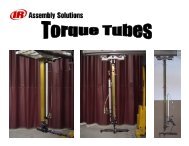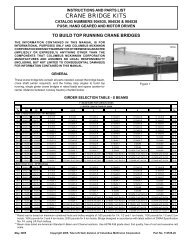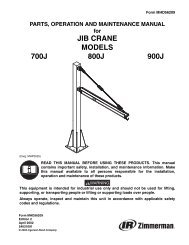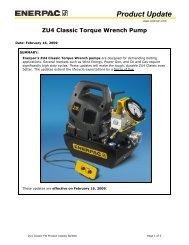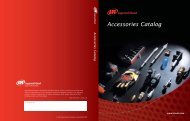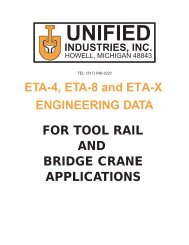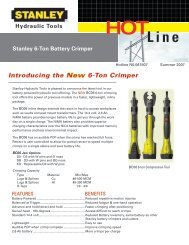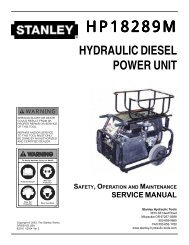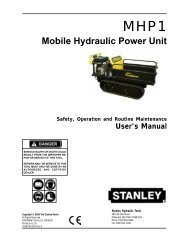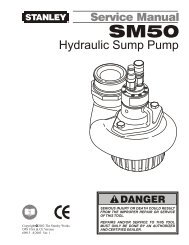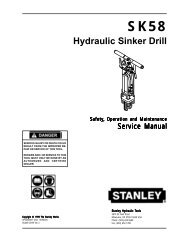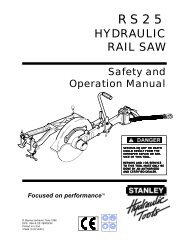hydraulic power unit twin circuit diesel - Tool-Smith
hydraulic power unit twin circuit diesel - Tool-Smith
hydraulic power unit twin circuit diesel - Tool-Smith
You also want an ePaper? Increase the reach of your titles
YUMPU automatically turns print PDFs into web optimized ePapers that Google loves.
ENGINE MAINTENANCE<br />
Follow the maintenance schedule and general maintenance<br />
instructions in the engine maintenance and operation manual<br />
furnished with the <strong>power</strong> <strong>unit</strong>. Normal maintenance includes:<br />
Inspect the air filter daily. Clean if necessary.<br />
Replace dry air filter every 200 hours of operation.<br />
Replace fuel filter every 100 hours of operation.<br />
Change engine oil after first 50 hours of operation, then<br />
after every 200 hours of operation. Change more often if cold,<br />
moist or dusty conditions exist.<br />
Change oil filter when engine oil is changed.<br />
Check oil level daily.<br />
Each day, remove dirt and debris from engine with a cloth<br />
or brush. Do not use water spray.<br />
HYDRAULIC SYSTEM MAINTENANCE<br />
Observe the following for maximum performance and service<br />
life from the <strong>hydraulic</strong> system.<br />
Always keep <strong>hydraulic</strong> system and fluids clean.<br />
Keep water out of fluid.<br />
ROUTINE MAINTENANCE<br />
Check <strong>hydraulic</strong> lines and fittings daily for leaks, kinks,<br />
etc. Do not use your hand to perform this check.<br />
Make sure the suction hose (from the <strong>hydraulic</strong> tank to the<br />
inlet manifold) is clamped securely. This reduces the risk of<br />
pump cavitation. All pump fittings should be tight.<br />
Change the <strong>hydraulic</strong> filter element every 200 hours of<br />
operation. Change more often if cold, moist or dusty conditions<br />
exist.<br />
Check oil cooler for debris. Remove debris with air pressure.<br />
Keep air out of <strong>hydraulic</strong> lines. Hydraulic system overheating<br />
and foam at the <strong>hydraulic</strong> tank breather indicate air is<br />
present in the lines. Keep all suction line fittings and clamps<br />
tight.<br />
13<br />
GENERAL MAINTENANCE<br />
Hydraulic system wear is noted by increased heat during<br />
tool operation, reduced tool performance and eventual<br />
system breakdown.<br />
Operate with the fluid temperature at 50° - 140° F/10° - 60°<br />
C for improved seal and hose life, and maximum efficiency.<br />
FILLING THE RESERVOIR<br />
1. Make sure the engine is stopped before opening the filler<br />
cap. Fill slowly with the recommended fluid as listed in the<br />
"Operation" section of this manual.<br />
2. Add fluid as needed. Stop filling when the sight pipe<br />
changes from center dark to full dark. Fluid must be visible<br />
in the sight pipe gauge at all times.<br />
3. Secure the filler cap before restarting the engine.<br />
REMOVING CONDENSED MOISTURE FROM<br />
HYDRAULIC FLUID<br />
Condensation is a frequent problem with cool <strong>hydraulic</strong><br />
<strong>circuit</strong>s. This condition occurs in moist or cold climates.<br />
When warm air in the <strong>hydraulic</strong> tank draws moisture from the<br />
cooler air outside, water accumulates in the tank.<br />
1. To remove water from the <strong>hydraulic</strong> system, use the<br />
"PRESSURE" hose without the quick-disconnect coupler<br />
attached. Start the engine and let it run at the idle speed.<br />
Pump the fluid into a clean 5 gal./20 ltr container.<br />
2. Turn the engine "OFF" as soon as the <strong>hydraulic</strong> tank<br />
(reservoir) is empty. DO NOT operate the engine with an<br />
empty <strong>hydraulic</strong> tank as pump damage may occur.<br />
3. Allow the fluid to sit long enough for the water to settle to<br />
the bottom of the container. Slowly pour the fluid back into<br />
the <strong>hydraulic</strong> tank, avoiding the water at the bottom of the<br />
container.



